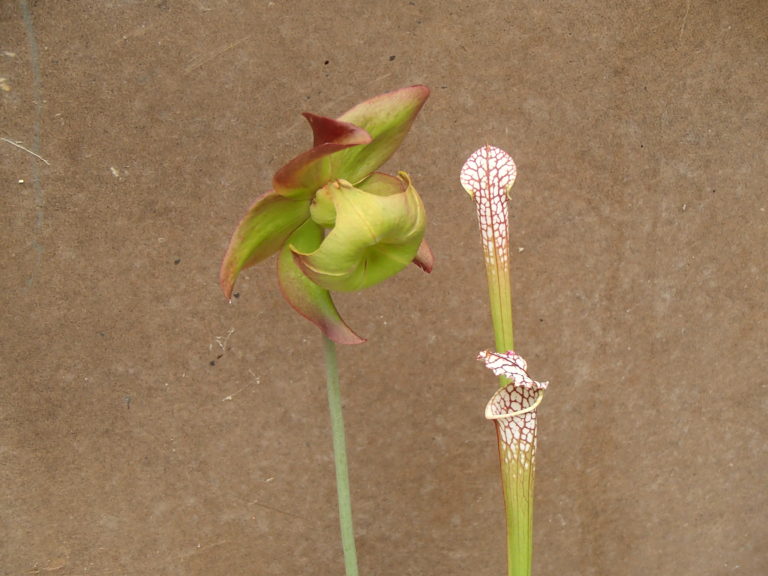White-topped Pitcherplant, according to Wikipedia, is not a N.C. native, but an introduction, actually endemic to Deep South gulf coastal areas. It is a popular pitcherplant because of its lovely coloration — with white pigmentation, delicately cut by green or red veins, on the hood and the uppermost part of the otherwise green tube or trap. Relatively slender pitchers are produced in spring and (more vigorously) in fall, dying back in winter. The lid or hood is frilly and erect or ascending, but not reflexed; the lip of the pitcher is large and often spouted, the orifice quite open. The flowers produced in springtime are red to maroon (matching the venation on the hood), dangling like an upside down umbrella from a leafless stalk. Having evolved in low nutrient, mucky coastal bogs of the deep South, these plants digest the soft parts of insect bodies caught in the traps to meet their nitrogen and phosphorus requirements. If not grown in such a bog they can be grown in containers, using peat moss and sand or perlite as substrate and deionized water (wet but not standing water), to avoid salt buildup. Of course one must never fertilize pitcherplants! They are fun and not difficult to grow if their needs for full sun during the growing season and cold temperatures in winter are met. S. leucophylla is threatened in its native habitat by development.
NURSERY HOURS
Wednesday: 10-4 Thursday: 10-6 Friday-Saturday: 10-4 Sunday: 12-4
Sarracenia leucophylla

Key Info
Scientific Name: Sarracenia leucophylla Raf.
Common Names: White-Topped Pitcherplant, Crimson Pitcherplant, Purple Trumpet-leaf or White Pitcherplant
Family Names: Sarraceniaceae
Light Requirement: Full sun
Additional Info
Habit: Sarracenias are clump-forming herbaceous perennials that grow as rosettes from a branching rhizome, forming colonies and containing fibrous roots 8-12 inches long along its length. The pitchers are modified leaves that (in addition to their function of photosynthesis) attract and entrap their insect prey by means of colorful presentation and nectar production (like flowers) and modifications to prevent escape. Wikipedia has a concise treatment of Sarracenia's entrapment mechanisms.
Height: 1'-3'
Spread: 1'-2'
Soil Conditions: Moist or wet, nutrient-poor, peaty, acidic soils.
Leaves: The pitchers are leaves modified to attract, capture, hold and digest animal prey. The pitchers of S. leucophylla consist of a more or less upright, slender tube (the trap) with a frilly hood poised at the top, the trap orifice being quite open. Each succeeding trap is generally taller than the last. S. leucophylla also produces long, slender, linear, winter leaves (phyllodia).
Flowers (or reproductive structures: Red petals hang down from inverted umbrella-like flowers. The flowers occur early in the season while pitchers are still small, and are above pitchers.
Fruit: Each flower is followed by a dry 5-parted seed capsule that splits open along 5 seams at maturity (June/July) exposing small, papery, pear-shaped seeds. The seeds fall near the parent plant.
Natural Distribution: Swampy nutrient poor soils.
USDA Hardiness Zone: 4 to 8
USDA Wetland Indicator Status in NC: OBL
Pollination: Bees, and other insects.
Wildlife Connections: Obtains nutrients (nitrate and phosphate) from insects. Insects and other tiny creatures are attracted by the nectar and coloration of the traps. The main prey of Sarracenias are ants, flies, wasps, bees, beetles, slugs and snails.
Propagation: Sarracenias can be propagated from seed or, more frequently, by division.
